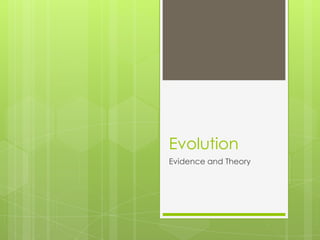
Evolution evidence and theory (2)
- 2. The Fossil Record Fossil is a trace of a long-dead organism. Found in sedimentary rock. Over long periods of time, hard minerals replace the tissue of the organism leaving rocklike structure behind. Robert Hooke (remember him) was one of the first scientists to study fossils. Published conclusion that fossils are the remains of plants and animals (1668)
- 4. Distribution of fossils Law of Superpostion: successive layers of rock or soil were deposited on top of one another by wind or water. The lowest stratum (layer) in a cross section of Earth is the oldest. The top stratum is the youngest (deposited most recently). Fossils found in the same layer are close to the same age.
- 6. Succession of Forms Fossil-bearing strata show that species of organisms appeared, existed for a while, and then disappeared (became extinct). Newer species arose. Fossil record indicates several mass extinctions (evidence indicates we are in the midst of the 6th mass extinction). http://news.discovery.com/videos/why- tell-me-why-mass-extinction.html
- 7. Biogeograhy Is the study of the geographical distribution of fossils and of living organisms. Comparison of fossil types with types of living organisms in the same geographic area shows that new organisms arise in areas where similar forms previously lived.
- 10. Lamarck’s Explanation 1744-1829 Similar species descended from a common (same) ancestor. Living species were descended from similar extinct species evident in fossil record. Lamarck was the first to clearly state that types of organisms change over time and that the new types are modified descendants of older types.
- 11. Lamarck: How species change. Acquired traits were passed to offspring. Acquired traits are NOT determined by genes, it arises during an organism’s lifetime as a result of the organism’s experience or behavior. Observation: Long neck on giraffes. Hypothesis: long neck resulted from repeated stretching to reach food higher and higher in trees. (acquired trait through habit).
- 13. Alfred Wallace and Charles Darwin Independently proposed species are modified by Natural Selection. Darwin is now remembered for it and Wallace forgotten because of Darwin’s book The Origin of Species published in 1859.
- 14. Natural Selection Organisms best suited to their environment (high fitness) REPRODUCE more successfully passing on their characteristics (through GENES/DNA). Over generations, the proportion of organisms with the favorable traits increase in a POPULATION. Individuals DO NOT evolve, populations do.
- 15. Charles Darwin Attended medical school then enrolled to study for the clergy. 1831 sailed on the H.M.S. Beagle as the naturalist on a 5-year mapping and collecting expedition to South America and the South Pacific. Darwin was responsible for collecting specimens and keeping careful records of his observations.
- 16. Voyage of the Beagle Darwin collected many types of fossils, specimens of organisms and observed thousands of species. Galapagos Islands http://science.discovery.com/videos/100- greatest-discoveries-shorts-natural- selection.html
- 17. Darwin’s Finches Collected 13 similar but separate species. Each finch species has a distinctive bill that is specialized for a particular food source. Similarities implied the finches shared a recent common ancestor. Offspring of original finches has been adapting to different environments and food sources. Over many millions of years, many large differences could accumulate between species.
- 18. Darwin’s Finches
- 19. Darwin’s Theories Descent with modification: the newer forms appearing in the fossil record are actually the modified descendants of older species. Modification by Natural selection: environment affects individual organisms in a population. Those best suited (best fit) survive, pass on the beneficial traits. Those with favorable traits have adaptive advantage. Selection conditions change as the demands of the environment changes.
- 20. Evolution in Process Evolution is a continuous process. Genotypic and phenotypic evidence in modern organisms indicates that evolution has occurred.
- 21. Evidence of Evolution Homologous and Analogous structures. Vestigial Structures Similarities in Embryology Similarities in Macromolecules.
- 22. Homologous Structures Similarfeatures that originated in a recent shared (common) ancestor. Same structure, may have different function.
- 23. Analogous Structures Same function, different structure No recent shared (common) ancestor.
- 24. Similar Structure = Similar Genes = Evolutionarily related!
- 25. Vestigial Structures Feature in an organisms that serves no current function (useless). Feature was useful to an ancestor.
- 26. Similarities in Embryology Early stages of different vertebrate embryos are strikingly similar to each other. “Embryological development repeats evolutionary history. Similarities are evidence that vertebrates share a common ancestry. http://www.dnatube.com/video/4207/Wh at-Can-Embryos-Tell-Us-About-Evolution
- 28. Similarities in Macromolecules What Darwin Didn’t Know: Similar traits because of similar DNA! DNA > transcription> RNA> translation > proteins (chains of amino acids) Similar proteins = similar DNA=shared ancestor The more similar the proteins in different species, the more closely related the species are.
- 29. Patterns of Evolution There are several ways that species (populations) can change to adapt to their habitats. The pattern and speed of evolutionary change result from the changing requirements of the environment. Changes place new selective pressures on the population.
- 30. Coevolution: change in two species in close association with each other.
- 32. video http://video.nationalgeographic.com/vid eo/player/animals/bugs-animals/ants- and-termites/ant_acaciatree.html
- 33. Convergent Evolution Organisms that appear very similar (sharks and porpoise) but are not closely related at all. Environment selects similar phenotypes, even though the ancestral types are very different. Analogous structures (fins) to perform similar functions in similar environment.
- 35. Divergent Evolution 2 or more related populations or species become more dissimilar (different). Result of differing habitats (environment). Can result in new species. Adaptive Radiation - many related species evolve from a single ancestral species. (Darwin’s finches) Artificial Selection – humans select for traits (breeding).
- 37. Fun Stuff http://www.pbs.org/wgbh/nova/evolutio n/guess-embryo.html http://www.pbs.org/wgbh/nova/evolutio n/zoo-you.html